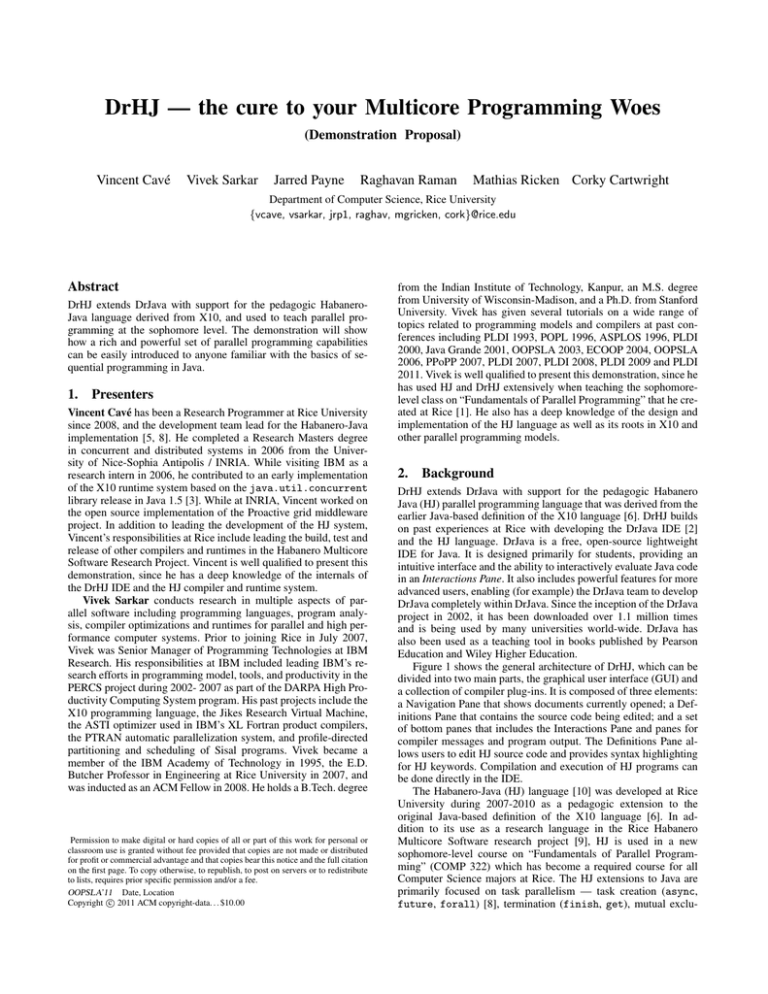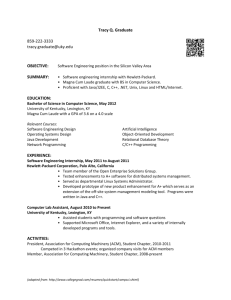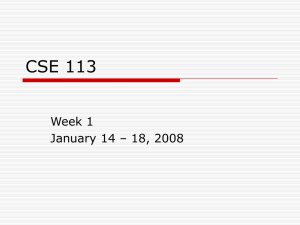DrHJ — the cure to your Multicore Programming Woes
advertisement

DrHJ — the cure to your Multicore Programming Woes
(Demonstration Proposal)
Vincent Cavé
Vivek Sarkar
Jarred Payne
Raghavan Raman
Mathias Ricken Corky Cartwright
Department of Computer Science, Rice University
{vcave, vsarkar, jrp1, raghav, mgricken, cork}@rice.edu
Abstract
DrHJ extends DrJava with support for the pedagogic HabaneroJava language derived from X10, and used to teach parallel programming at the sophomore level. The demonstration will show
how a rich and powerful set of parallel programming capabilities
can be easily introduced to anyone familiar with the basics of sequential programming in Java.
1.
Presenters
Vincent Cavé has been a Research Programmer at Rice University
since 2008, and the development team lead for the Habanero-Java
implementation [5, 8]. He completed a Research Masters degree
in concurrent and distributed systems in 2006 from the University of Nice-Sophia Antipolis / INRIA. While visiting IBM as a
research intern in 2006, he contributed to an early implementation
of the X10 runtime system based on the java.util.concurrent
library release in Java 1.5 [3]. While at INRIA, Vincent worked on
the open source implementation of the Proactive grid middleware
project. In addition to leading the development of the HJ system,
Vincent’s responsibilities at Rice include leading the build, test and
release of other compilers and runtimes in the Habanero Multicore
Software Research Project. Vincent is well qualified to present this
demonstration, since he has a deep knowledge of the internals of
the DrHJ IDE and the HJ compiler and runtime system.
Vivek Sarkar conducts research in multiple aspects of parallel software including programming languages, program analysis, compiler optimizations and runtimes for parallel and high performance computer systems. Prior to joining Rice in July 2007,
Vivek was Senior Manager of Programming Technologies at IBM
Research. His responsibilities at IBM included leading IBM’s research efforts in programming model, tools, and productivity in the
PERCS project during 2002- 2007 as part of the DARPA High Productivity Computing System program. His past projects include the
X10 programming language, the Jikes Research Virtual Machine,
the ASTI optimizer used in IBM’s XL Fortran product compilers,
the PTRAN automatic parallelization system, and profile-directed
partitioning and scheduling of Sisal programs. Vivek became a
member of the IBM Academy of Technology in 1995, the E.D.
Butcher Professor in Engineering at Rice University in 2007, and
was inducted as an ACM Fellow in 2008. He holds a B.Tech. degree
Permission to make digital or hard copies of all or part of this work for personal or
classroom use is granted without fee provided that copies are not made or distributed
for profit or commercial advantage and that copies bear this notice and the full citation
on the first page. To copy otherwise, to republish, to post on servers or to redistribute
to lists, requires prior specific permission and/or a fee.
OOPSLA’11 Date, Location
c 2011 ACM copyright-data. . . $10.00
Copyright from the Indian Institute of Technology, Kanpur, an M.S. degree
from University of Wisconsin-Madison, and a Ph.D. from Stanford
University. Vivek has given several tutorials on a wide range of
topics related to programming models and compilers at past conferences including PLDI 1993, POPL 1996, ASPLOS 1996, PLDI
2000, Java Grande 2001, OOPSLA 2003, ECOOP 2004, OOPSLA
2006, PPoPP 2007, PLDI 2007, PLDI 2008, PLDI 2009 and PLDI
2011. Vivek is well qualified to present this demonstration, since he
has used HJ and DrHJ extensively when teaching the sophomorelevel class on “Fundamentals of Parallel Programming” that he created at Rice [1]. He also has a deep knowledge of the design and
implementation of the HJ language as well as its roots in X10 and
other parallel programming models.
2.
Background
DrHJ extends DrJava with support for the pedagogic Habanero
Java (HJ) parallel programming language that was derived from the
earlier Java-based definition of the X10 language [6]. DrHJ builds
on past experiences at Rice with developing the DrJava IDE [2]
and the HJ language. DrJava is a free, open-source lightweight
IDE for Java. It is designed primarily for students, providing an
intuitive interface and the ability to interactively evaluate Java code
in an Interactions Pane. It also includes powerful features for more
advanced users, enabling (for example) the DrJava team to develop
DrJava completely within DrJava. Since the inception of the DrJava
project in 2002, it has been downloaded over 1.1 million times
and is being used by many universities world-wide. DrJava has
also been used as a teaching tool in books published by Pearson
Education and Wiley Higher Education.
Figure 1 shows the general architecture of DrHJ, which can be
divided into two main parts, the graphical user interface (GUI) and
a collection of compiler plug-ins. It is composed of three elements:
a Navigation Pane that shows documents currently opened; a Definitions Pane that contains the source code being edited; and a set
of bottom panes that includes the Interactions Pane and panes for
compiler messages and program output. The Definitions Pane allows users to edit HJ source code and provides syntax highlighting
for HJ keywords. Compilation and execution of HJ programs can
be done directly in the IDE.
The Habanero-Java (HJ) language [10] was developed at Rice
University during 2007-2010 as a pedagogic extension to the
original Java-based definition of the X10 language [6]. In addition to its use as a research language in the Rice Habanero
Multicore Software research project [9], HJ is used in a new
sophomore-level course on “Fundamentals of Parallel Programming” (COMP 322) which has become a required course for all
Computer Science majors at Rice. The HJ extensions to Java are
primarily focused on task parallelism — task creation (async,
future, forall) [8], termination (finish, get), mutual exclu-
sion (isolated), phasers [12]1 , and hierarchical places. Similar
extensions to C and Scala are being pursued in the Habanero C
and Habanero Scala projects at Rice. HJ has also been used as a
foundation to implement higher-level programming models such as
Intel’s Concurrent Collections [4].
other compiler plugins
HJ compiler plugin
HJ Source Code
Polyglot
Navigation Pane
GUI
Definitions Pane
Interactions Pane
Configuration:
Keywords
File extensions
AST
Dr Habanero
Interpreter
JUnit
JRE
Race Detector
Class files
Figure 1. Architecture of the DrHJ IDE
3.
Description of Demonstration
This demonstration shows how a rich and powerful set of parallel
programming capabilities can be easily introduced to anyone familiar with the basics of sequential programming in Java using the
HJ language and the DrHJ IDE. The demo will start with a publicly available download of a single jar file for DrHJ that requires
no installation, assuming that a Java Runtime Environment (JRE) is
available. We will step through a selected number of laboratory assignments from the COMP 322 class at Rice. For each example, we
will show how a sequential Java program can be easily converted
to a parallel program. The HJ compiler is integrated with the DrHJ
IDE using a standard plug-in interface. Compiler error messages
are transferred back to the IDE and displayed in one of the bottom
panes. If compilation is successful, the user can invoke the program
by pressing the Run toolbar button, or by using the run keyword
in the Interactions Pane, followed by the name of the program’s
main class, and an optional list of arguments for the program (for
example: run Fib 10).
DrHJ also includes a tool to detect data races in HJ programs,
based on the ESP-bags algorithm developed for HJ [11]. The ESPbags algorithm is a generalization of the SP-bags algorithm developed for Cilk’s spawn and sync constructs [7]. Like SP-bags, ESPbags works by following a depth-first execution of a sequentialized version of the parallel program. The extensions in ESP-bags
were necessary because the set of computation graphs generated by
async-finish constructs in HJ is more general than the graphs generated by spawn-sync constructs in Cilk. The DrHJ data race detector
currently supports HJ programs that contain only finish, async
and isolated constructs, since those programs can be easily sequentialized. An important property of the DrHJ data race detector
is that it uses the depth-first execution to report all potential races
that may be encountered for a given input.
While this demonstration will show how multicore programming can be performed simply using the HJ language and the DrHJ
1 The latest release of j.u.c in Java 7 includes Phaser synchronizer objects,
which are derived in part from the phaser construct in HJ.
References
[1] Comp 322: Fundamentals of parallel programming.
URL
https://wiki.rice.edu/confluence/display/PARPROG/COMP322.
Runtime Libraries
Soot
Dr Habanero
Test Harness
IDE, a number of technical challenges had to be overcome in building this system. First, the compiler and the runtime system are
all implemented in Java to ensure portability. In fact, HJ’s parallel runtime system leverages a number of low-level capabilities in
the java.util.concurrent library. Second, we have to distinguish between the main JVM that executes the DrHJ IDE, and the
the “Interpreter JVM” that executes HJ applications. DrHJ’s main
JVM communicates with the Interpreter JVM using Java’s Remote
Method Invocation (RMI) API. Any output produced by the Interpreter JVM is forwarded back to DrHJ to be displayed in the
Interactions Pane. Third, DrHJ includes a state-of-the-art data race
detector that tracks locations in Java objects and arrays. Finally, all
the parallel primitives have highly efficient and scalable implementations on multicore processors.
[2] Eric Allen, Robert Cartwright, and Brian Stoler. Drjava: a lightweight
pedagogic environment for java. In Proceedings of the 33rd SIGCSE
technical symposium on Computer science education, SIGCSE ’02,
pages 137–141, New York, NY, USA, 2002. ACM. ISBN 158113-473-8. doi: http://doi.acm.org/10.1145/563340.563395. URL
http://doi.acm.org/10.1145/563340.563395.
[3] Rajkishore Barik, Vincent Cave, Christopher Donawa, Allan Kielstra,
Igor Peshansky, and Vivek Sarkar. Experiences with an SMP Implementation for X10 based on the Java Concurrency Utilities. In Workshop on Programming Models for Ubiquitous Parallelism (PMUP),
held in conjunction with PACT 2006, Sep 2006, 2006.
[4] Zoran Budimlić, Michael Burke, Vincent Cavé, Kathleen Knobe, Geoff Lowney, Ryan Newton, Jens Palsberg, David Peixotto, Vivek
Sarkar, Frank Schlimbach, and Sağnak Taşırlar. Concurrent Collections. SIAM PP10, Special Issue on Scientific Programming, 2010.
[5] Vincent Cavé, Zoran Budimlić, and Vivek Sarkar.
Comparing the usability of library vs. language approaches to task parallelism.
In Evaluation and Usability of Programming Languages and Tools, PLATEAU ’10, pages 9:1–9:6, New York,
NY, USA, 2010. ACM.
ISBN 978-1-4503-0547-1.
URL
http://doi.acm.org/10.1145/1937117.1937126.
[6] P. Charles et al.
X10: an object-oriented approach to nonuniform cluster computing.
In OOPSLA’05, pages 519–538,
New York, NY, USA, 2005.
ISBN 1-59593-031-0.
doi:
http://doi.acm.org/10.1145/1094811.1094852.
[7] Mingdong Feng and Charles E. Leiserson. Efficient detection of
determinacy races in cilk programs. In SPAA ’97: Proceedings of
the ninth annual ACM symposium on Parallel algorithms and architectures, pages 1–11. ACM, 1997. ISBN 0-89791-890-8. doi:
http://doi.acm.org/10.1145/258492.258493.
[8] Yi Guo, Jisheng Zhao, Vincent Cavé, and Vivek Sarkar. Slaw: a scalable locality-aware adaptive work-stealing scheduler. In IPDPS ’10:
Proceedings of the 2010 IEEE International Symposium on Parallel&Distributed Processing, pages 1–12, Washington, DC, USA, Apr
2010. IEEE Computer Society.
[9] Habanero. Habanero multicore software research project web page.
http://habanero.rice.edu, January 2008.
[10] Habanero. Habanero Java. http://habanero.rice.edu/hj, Dec 2009.
[11] Raghavan Raman, Jisheng Zhao, Vivek Sarkar, Martin Vechev, and
Eran Yahav. Efficient data race detection for async-finish parallelism.
In RV’10, Proceedings of the 1th International Conference on Runtime
Verification. Springer, Nov 2010.
[12] J. Shirako et al. Phasers: a unified deadlock-free construct for collective and point-to-point synchronization. In ICS ’08, pages 277–288,
New York, NY, USA, 2008. ACM. ISBN 978-1-60558-158-3. doi:
http://doi.acm.org/10.1145/1375527.1375568.
Figure 2. DrHJ GUI screenshot featuring the HJ data race detector. This screenshot shows a simple program ArraySum.hj, that attempts to
use two tasks to sum the elements of an array. The child async task in lines 50–54 computes the sum of elements X[0 . . . mid] in X[0].
The parent task computes the sum of elements X[mid . . . n − 1] in X[mid] in parallel with the child task, and then adds X[0] and X[mid]
in line 60 after the finish statement which ensures the completion of the child task. However, this code contains an error because X[mid]
is read by the child task, and is also read and written by the parent task. This error is reported as a data race by DrHJ, as shown in the
Interactions Pane in figure 2. The error report includes the source coordinates for the two conflicting accesses as well as the index of the array
location on which the race occurs.




